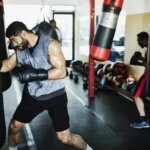Setting up a punching bag in your house is an excellent way to release some of your pent-up energy without getting anybody hurt. It’s also great for getting a full-body workout and improving overall fitness without weights or other gym equipment.
Not all punching bags are constructed similarly, though. You ought to be aware of different punching bags when purchasing a new punching bag.
This article will cover choosing the right punching bag to get your punching and kicking technique right! So stick around.
Heavy Bags
Heavy bags are arguably the most common among the various punching bags. They’re cylindrical and often hang from the ceiling. As the name suggests, these punching bags are so heavy that they’re excellent for strength training and can resist most strikes.
How heavy are we talking, exactly? Most heavy-hanging punching bags weigh between 70 and 150 lbs, filling most of them with a cloth. Keep in mind, however, that with such weight comes immobility. So, if you’re looking for a punching bag that you can reposition constantly, you might want to consider a different type.
If you’re looking to buy a heavy bag, you must ensure your ceiling can handle its weight. You should also consider the size of the bag relative to your needs. To ensure you buy the right heavy bag, divide your body weight by two. For instance, if you weigh 180 lbs, you’ll need a heavy bag that weighs around 90 lbs.
Check out the Viking Baltic Leather Pro.
Teardrop Bags
Teardrop punching bags are variants of heavy bags because they hang from the ceiling and have approximately the same weight range. The difference is that teardrop bags are less uniform in shape than heavy bags. As the name implies, they look like a teardrop.
While heavy bags are perfect for punching and kicking, teardrop bags are ideal for uppercutting, kneeing, and elbowing. So, you’ll be able to get a pretty diverse boxing workout from a teardrop bag.
Check out the Viking Giant Power Core 2.0.
Free-standing Bags
Are you not looking for a punching bag hanging from the ceiling but don’t want to compromise on weight? Your best bet is a free-standing punching bag. These models are fixed to a sturdy base to help keep them in place without the need to hang them from the ceiling.
The base is typically a composite material filled with sand or water. Free-standing bags are generally shorter than heavy bags and ideal for kicking. We wouldn’t recommend a free-standing bag if you’re looking for easy uppercuts.
We love the most about free-standing punching bags because even though they’re relatively heavy and provide remarkable resistance, they’re still easy to move around.
Check out the Shinobi Free Standing Punching Bag.
Body Bags
Body bags are free-standing punching bags that adopt the shape of an actual human being rather than a uniform cylindrical shape, which makes them optimal for MMA enthusiasts and grappling purposes.
Body bags are about the same weight as standard free-standing bags, so they’re relatively easy to move around. They’re also situated on a sturdy base often filled with sand or water, delivering outstanding resistance.
Check out the Shinobi Bob Human Punching Bag.
Speed Bags
Next, we have speed bags, which are pretty self-explanatory. These are punching bags designed to deliver a quick snap-back action. These bags are much smaller and are one of the lighter bags out of all the punching bag types.
Speed bags are typically filled with just air, so you shouldn’t expect much resistance from them. Their primary purpose is to help the user improve hand-eye coordination and timing, not develop strength.
Despite their inability to deliver excellent resistance, speed bags can still be employed for aerobic exercise because you’re still using integral body parts to punch them. They’re just most suitable for those who champion fitness over body strength.
If you’ve never used a speed bag before, we strongly recommend opting for a larger bag, as it’ll be slower and easier to strike. Once you’re confident in your speed, you can opt for a small bag.
Check out the Sting Pro Leather Speedball.
Double End Bags
The final punching bag we’re going to discuss is double end bags, which are variants of speed bags. As the name suggests, these punching bags have two ends; one is attached to the floor while the other is fixed to the ceiling. If you seek mobility, this type isn’t for you.
Double-end punching bags flaunt a much better range of motion than standard speed bags, and they’re somewhat able to strike back, helping the user develop fast reflexes. If you want a bag to help you prepare for combat with a target that can hit back, a double-end punching bag is your best bet.
Check out the Cleto Reyes Double End Bag.
Purchasing Your New Punching Bag
There you have it; the different types of punching bags you’ll find on the market. Your choice should boil down to a few factors, including the punching bag size and similar weight range to your body, the type of workout you want to engage in, and whether you champion strength or fitness.
If you purchase a heavier bag, remember to check you have a sturdy place to hang it in your training space.
You can choose which material you like, whether synthetic leather or genuine leather.
Hopefully, the information provided in this article has given insight into which type of punching bag is ideal for you.
Our team is always available if you need assistance choosing a new punching bag, so don’t hesitate to reach out to us!






